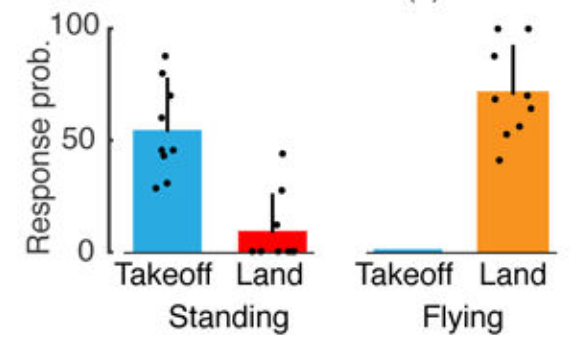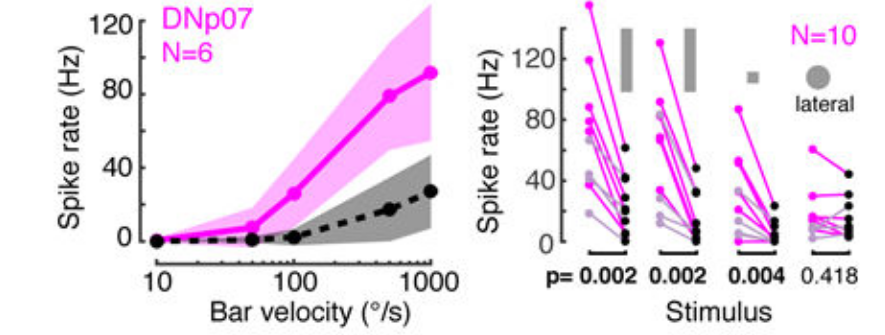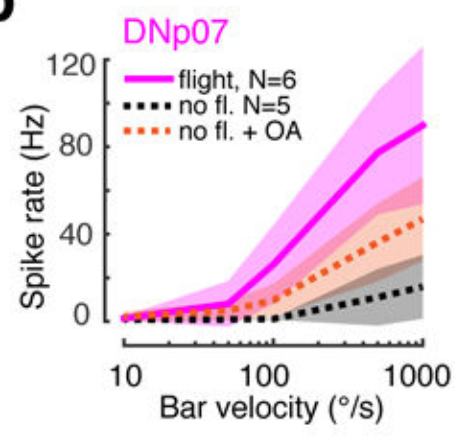State-dependent decoupling of sensory and motor circuits underlies behavioral flexibility in Drosophila
authors: Jan M. Ache, Shigehiro Namiki, Allen Lee, Kristin Branson, Gwyneth M. Card
doi: 10.1038/s41593-019-0413-4
CITATION
Ache, J. M., Namiki, S., Lee, A., Branson, K., & Card, G. M. (2019). State-dependent decoupling of sensory and motor circuits underlies behavioral flexibility in Drosophila. Nature Neuroscience, 22(7), 1132–1139. https://doi.org/10.1038/s41593-019-0413-4
ABSTRACT
fleeting notes
- how do flies distinguish self motion from looming visual stimuli to activate different behaviors
- two descending neurons that control landing and behavioral flexibility
- silencing impairs landing
- activation drives landing
- spike rate determines leg extension amplitude
- DN activity attenuated during non flight periods
- decouples visual stimuli from landing when not appropriate
- octopamine exposure mimics flight effects in DN
- sensory and motor netowrks are coupled or decoupled according to behavioral state
looming feature detectors convey visual information to VNC for takeoff response
-
looming circuits have been well studied
- 2 projection neurons from optic lobes are looming feature detectors and synapse onto giant fiber descending neuron which activates motor neurons in VNC to initiate takeoff
- Wu.etal2016 mapped the LC neuron types each capture specific visual features
- Klapoetke.etal2017 figured out the giant fiber receives looming visual input from LPLC2
-
optogenetically activated 133 DN split gal4 lines to find landing control neurons\
-
only DNp07 and DNp10 elicited landing extensions of all six legs
-
silencing DNp07 or DNp10 reduced landing in response to looming stim
looming stimulus evokes opposite behaviors depending on behavioral state
DNp07 elicits visually evoked landing motor patterns during flight
DNp10 elicits visually evoked landing motor patterns during flight
-
presented visual stimuli and saw spiking in DNp07 and DNp10 which preceded leg movements
- also found that spike rate correlated with leg extension amplitude
- tuned opto stim to match visual stim and more intense stim resulted in large leg amplitudes
-
visual responses in DNp10 were eliminated without flight
-
visual responses in DNp07 were reduced below spike rate required for leg movement activation
-
gating of landing happens at the level of DN dendrites
- opto activation of DNs in non flying flies produce landing like extensions
-
octopamine activity increases during flight
- bath application and release by activation of neurons mimic flight state and increase responses of visual interneurons
-
gating of responses in DNp07 is mediated by octopamine but DNp10 is not
-
DNp10 gets tonically depolarized during flight and repolarized at flight cessation
- this indicates that DNp10 gets direct feedback from flight circuitry either from mechanosensory feedback or input from motor
highlights
“Thus, this sensorimotor flexibility arises from distinct mechanisms for gating action-specific descending pathways, such that sensory and motor networks are coupled or decoupled according to the behavioral state.”Page 1
“Supra-threshold visual responses were completely eliminated without flight in DNp10”Page 5
“We observed that DNp10 was tonically depolarized during flight and quickly repolarized at flight cessation”Page 7
“Gating of DNp07 activity is mediated by neuromodulation of the sensorimotor circuit through OA”Page 8
“Gating of DNp10 activity, on the other hand, is most likely achieved by direct feedback from flight motor circuits onto the DN itself, which would explain the tonic depolarization of DNp10 during flight”Page 8
“This feedback could, for example, be provided by ascending neurons that project from the flight motor circuit in the VNC directly onto DNp10 dendrites in the brain or gnathal ganglion29.”Page 8
“This suggests that state-dependent gating of DN activity could be a general principle by which nervous systems flexibly couple sensory features to motor pathways in order to rapidly select an appropriate action”Page 8






